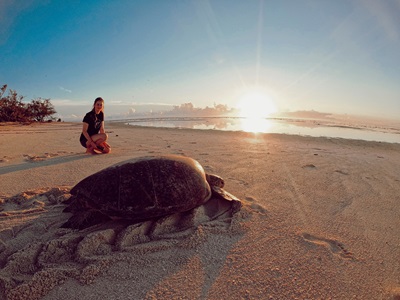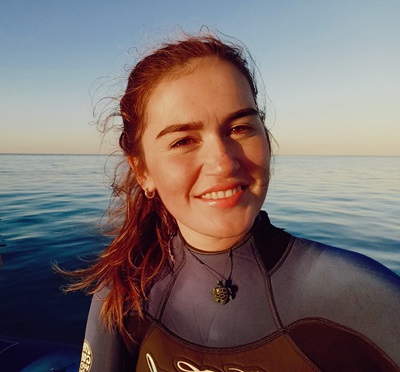
A group of islands just offshore of Papua New Guinea is offering hope for endangered marine turtles facing a higher-temperature-induced “man drought”.
University of Queensland-led research, conducted in PNG’s remote Conflict Islands, has revealed that green and hawksbill turtle populations in the islands are bucking global trends, and are likely producing balanced sex ratios of hatchlings.
UQ PhD candidate, Melissa Staines, explained that sex of a turtle embryo is determined by nest temperature – hotter nests produce more females, while cooler nests produce more males.
“Some sea turtle populations globally are now facing the threat of ‘feminisation’ due to human-induced climate warming that is increasing sand temperatures at nesting sites at an unprecedented rate,” Ms Staines said.
“And, despite this site’s current balanced sex ratio, the hatchling sex ratio is expected to become more female-biased over the next 80 years, with an average of 76 to 87 per cent female.
“But that’s far better than Queensland’s Raine Island – the largest green turtle rookery in the world – where green turtle hatchling sex ratios are currently more than 99 per cent female.”

Despite being similar distances from the equator, researchers say there are several reasons why the Conflict Islands and Raine Island may have such different sex ratios.
“Many factors can influence sand temperature such as rainfall, beach orientation and shade from vegetation, and we accounted for these factors in our analyses,” Ms Staines said.
“Cooler sand temperatures within the Conflict Islands are likely due to high rainfall and the dense tropical forest that fringes the dunes where the turtles lay their eggs, meaning natural nests are shaded for most of the day.
“In contrast, Raine Island has no trees, so all nests are exposed to full sun every day and is likely a key contributing factor to the extremely female-biased hatching sex ratios.”
“Nesting locations that are still producing balanced hatchling sex ratios are likely very scarce.
“So, importantly, nesting sites like the Conflict Islands, which continue to generate significant numbers of male hatchlings, will be critical to the survival of future populations both in the Coral Sea and globally.”
Hayley Versace, a co-author and manager at Conflict Islands Conservation Initiative, said that, despite trends of feminisation, other threats were more immediate in the Conflict Islands.
“Our conservation efforts can be focused on more immediate threats such as sea level rise and the take of eggs and turtles,” she said.
This research is part of the WWF Australia-led Turtle Cooling Project, which is investigating ways to cool sand temperatures and re-establish more natural gender numbers of offspring where needed.
 UQ’s Dr David Booth said the project has already shown that a one-off application of seawater can produce a short-term drop in nest temperature by two degrees Celcius, enough to generate more male hatchlings.
UQ’s Dr David Booth said the project has already shown that a one-off application of seawater can produce a short-term drop in nest temperature by two degrees Celcius, enough to generate more male hatchlings.
“Unlike freshwater, seawater is abundant at all nesting sites and seawater irrigation may be a strategy for turtle rookeries facing extreme feminisation,” Dr Booth said.
“Innovative interventions such as the Turtle Cooling Project are increasingly important, because they play a vital role in regenerating nature and ensuring no future extinctions to beautiful species such as these turtles.”
The research is published in Global Change Biology.
Media: Melissa Staines, m.staines@uq.edu.au; Dr David Booth, d.booth@uq.edu.au, +61 403 858 940; Faculty of Science Media, science.media@uq.edu.au, +61 438 162 687.



